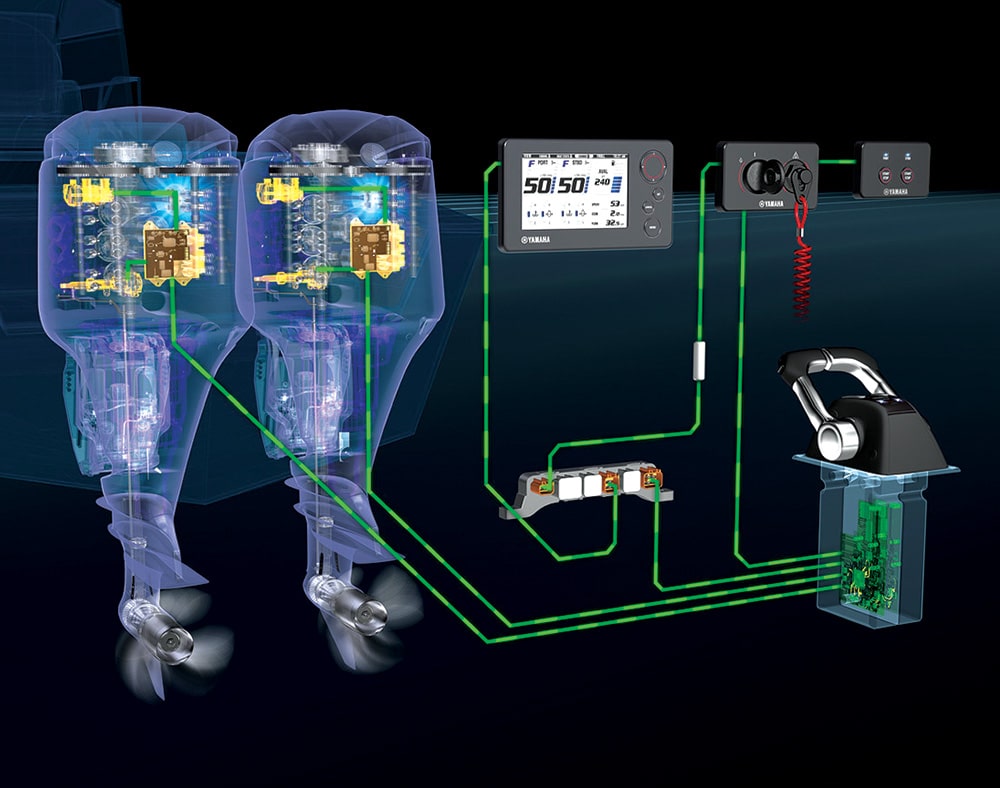
How to Upgrade to Digital Engine Controls
Despite any wariness you might have about new technology, digital engine controls and instrumentation are definitely better than mechanical and analog, says David Meeler, the marine product information manager for Yamaha Outboards. “You are going to be impressed with the smoothness and level of control,” he says.
While engine companies such as Yamaha offer more traditional control and instrumentation types, the trend is toward digital. Consider these six factors if you are thinking of upgrading.
1. Fresh Harness
Each engine will require a new control harness. “That’s something I recommend with any repower,” Meeler says, “even if you’re not changing engine brands or control systems.” Use old harnesses to pull the new ones through the rigging tube.
You might also need a few control hubs. With the Yamaha system, for example, you need one by the engine and another one or two near the helm. Everything is plug-and-play with color-coded ports and plugs to simplify installation.
2. New Control Box
For digital “fly-by-wire” throttle and shift, you need a new control box. Yamaha’s digital control box has the same footprint as its mechanical one, so it’s an easy retrofit. Plus, you get automatic engine synchronization with multiple outboards. That means you can ditch your old, unwieldy control cables.
One word of warning: Digital controls are far more responsive than cables, so use a much lighter touch, especially when maneuvering around docks or when the crew is not prepared for a sudden lurch. I speak from experience. For the uninitiated, Meeler recommends increasing the throttle friction control, which is adjusted via a screw under the control box cover.
3. Different Instruments
You won’t need to redo the boat’s dash to accept new digital instrumentation. “Yamaha’s digital gauges are designed to fit in the same size holes as analog gauges, which simplifies the retrofit,” Meeler explains. “Yet many boat owners take the opportunity to redesign their dashes.”
Digital instrumentation takes different forms. Yamaha’s Command Link Plus and Mercury’s VesselView7, for example, are flat-panel displays that allow you to view virtually all engine parameters. That can save a lot of real estate at the helm, allowing you to use the newfound space for other electronics.
4. System Integration
With many digital systems, you can display engine data on virtually any NMEA 2000-compatible multifunction display. Plug-and-play cabling makes such system integration easy to achieve.
5. Keyless Ignition
Some digital control systems feature keyless ignition, which means you might have to buy a new start/stop panel to replace the faceplate for the key ignition switch at the helm and install a keyed switch behind the helm or in the cabin.
6. Extra Cost
So what are you looking at in terms of additional cost for an engine with digital controls and instruments versus the old-school equipment? For Yamaha outboards, it works out to approximately 30 percent more, Meeler says. That includes the extra items such as a control box, hubs, keyless panels and instrumentation.
Is it worth it? When I talk to boaters who have already gone digital, I get the feeling that they would never go back.
Quick Tip: Fly-by-wire controls automatically synchronize rpm using a single throttle lever for multiple engines.









